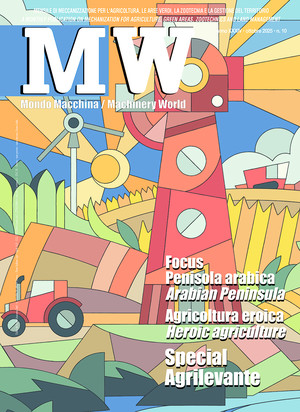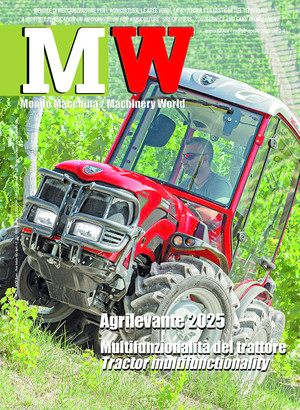
Special steels for sector components
Special alloys of chromium or carbon, combined with technical ceramic inserts, prolong the life of components subjected to higher stress. A market that is in constant growth, primarily supported by the most structured companies
Agricultural machines are made of iron. More precisely, they are made of steel. The proportion of silicon (a metaphor for electronics) is constantly increasing, but steel remains, and will remain for a long time, the primary component, at least in terms of volume. But what kind of steel? There is steel and steel: it varies based on the elements that compose it, its hardness, elasticity, and abrasion resistance. Within the same tool, various types of steel can be found, and even a single type of steel contains numerous components, all playing a specific role. A small variation in the percentage of any one of them can radically alter performance. Special steels are used for some highly sophisticated parts - consider the special alloys used in pistons or engine barrels - but also for much simpler components, such as the tines of soil-working tools or the blades of a cutting rotor. Many of these parts are also available in different versions: a standard one, which is more or less sophisticated depending on the equipment's price range, and one or more high-resistance versions, meaning they are made from special steels or coated with wear-resistant materials. It's these latter options and their market share that we will discuss in the following pages.
Every part has its replacement. Let's start by defining the scope: we are concerned with parts of equipment or machines that, being subjected to strong stress, are made from materials different from common steel. They can be factory-mounted on new machines or, more often, offered as spare parts. This way, a farmer facing premature wear of these components can find a solution that avoids repeated machine downtime and unplanned maintenance. This is a significant issue: parts that wear out quickly reduce the machine's efficiency and necessitate replacements sooner than expected. It is not merely a matter of costs - although the price of spare parts is consistently rising and thus impacts the machine's amortization expenses - but of the downtime of the tool and the labor required for its restoration. Maintenance is traditionally performed during the winter season, when field activities slow down. However, if wear is rapid and work hours are numerous, it is not guaranteed that the tool can endure an entire campaign, even if it starts in the best possible condition. A rotary harrow tasked to work five or six hundred hectares, especially in areas with rocky or sandy soil, will require the replacement of the tines mid-season. This is certainly not a substantial effort, but what about much more complex operations, such as replacing the recovery auger of a rice harvester? This intervention is done in winter, but still requires trained personnel and entire workdays. For cases like this, as well as many others, manufacturers have been offering customers a special series of spare parts made from high-resistance materials for some years now. They cost significantly more than traditional equivalents but ensure vastly superior durability.
The concept of TCO. In the industrial and tertiary sectors, TCO is a commonly used term: one of many Anglo-Saxon acronyms that encapsulates a crucial concept. TCO (Total Cost of Ownership) is a principle to keep in mind when planning a purchase. It means calculating, for that investment, not only the initial cost but the entire expense that that asset will require over its useful life. To clarify with an example: a high-tech tractor certainly costs more than a similarly powered low-cost model. However, it might ensure certain savings - such as in fuel consumption - or increased productivity that could reduce, if not eliminate, the initial gap. If a tractor consumes less and can work more hectares per day or save many hours of office work thanks to automatic activity recording, it could prove more cost-effective than a cheaper, less efficient model. The same principle can be applied to any purchase, including spare parts. And let’s state it upfront: this is one of the most commonly used arguments by manufacturers of high-end machinery to persuade potential buyers: our products cost more, but over their lifespan, all things considered, they end up costing less.
Comparing solutions. In the case of spare parts, the factors affecting TCO are essentially the purchase price, durability, maximum efficiency lifespan, and the labor cost required for replacement. On the first point, there's no comparison. A high-resistance spare part typically costs twice as much as a traditional one, with peaks of 400% to 500% for certain solutions. However, manufacturers claim that it offers a service life at least five times longer than that of a typical spare part. This would already suffice to balance the total expenditure.
Additionally, there are labor savings from the four or five replacements that are no longer necessary, as well as increased earnings from avoiding machine downtime. The latter actually occurs only if the maintenance intervention must be carried out during the campaign. Finally, an often overlooked aspect: a partially worn component, although still usable, leads to reduced efficiency. A tine of a harrow worn down by a third does less work than a new one; a rounded anchor tip increases power absorption and thus the tractor's fuel consumption. Conversely, a component that remains practically unchanged for double or triple the time ensures more hours of work at 100% of the tool’s potential.
Special materials: but which ones? Until now, we've been vague, referring to special materials in a generic manner. Upon closer examination, we discover that there are at least three distinct quality levels for high-resistance components. The first uses steels with specially formulated compositions, which vary according to the characteristics one wishes to enhance: wear resistance, tensile strength, compressive strength, or greater elasticity, or lightness compared to a traditional alloy. In recent years, for instance, many have emphasized the use of Hardox in promotional campaigns, which is the name given to a specific high-chromium wear-resistant steel with low to medium carbon content. It has been (and still is) used because it combines high hardness (up to 500 HB on the Brinell scale) with good workability. In other cases and sectors, other Swedish steels, such as Domex and Strenx, which are particularly resistant to traction, have been employed. However, not always is a high-carbon, chromium, or manganese steel alloy sufficient to meet the high specifications required by certain components.
When steel is not enough. In such situations, even the hardest materials - among the hardest currently known - are utilized, including technical ceramics. The name alone might not evoke something suitable for reinforcing steel, yet that is precisely what happens. Chemically, a ceramic is defined as a compound produced by the high-temperature sintering of powders, such as oxides, carbides, borides, or other compounds. In recent years, tungsten carbide reinforcements have gained popularity; it is, after all, a technical ceramic composed of tungsten and carbon on a nickel or cobalt alloy metal base, which serves as a binder and provides toughness and stability to the ceramic, thereby reducing its intrinsic brittleness. Nevertheless, tungsten carbide, due to its hardness, remains a challenging material to work with and has an exceedingly high cost - this is partly because this element is found in very low concentrations within minerals like scheelite or wolframite. From processing one ton of soil and rocks, approximately 3 kg of pure tungsten is obtained, and transforming it into tungsten carbide requires a further complex and costly economic and environmental procedure. To such an extent that the European Union has issued specific regulations on accountability and social and environmental sustainability regarding this and other compounds to ensure they do not lead to human labor exploitation or excessive environmental damage during extraction and processing.
Scarcity, high cost, and processing difficulties mean that this ceramic, also known by the commercial name Widia (one of the first companies to produce it), is used in the form of plates or inserts. Essentially, tungsten carbide plates are fixed onto a component or a specific part of it to make it extremely resistant to abrasion and wear. In other cases, true inserts are created and integrated into the piece, replacing specific parts of it. The two solutions can be broadly considered equivalent, but while the plate modifies the profile and shape of the component, remaining essentially an add-on, the insert is an integral part of it; therefore, a replacement with Widia inserts is entirely similar to a bare replacement - except, of course, for the altered characteristics of hardness and resistance.
Tungsten carbide is not the only technical ceramic used to reinforce specific parts of a tool. In the past, but still today, coatings of chrome carbide have been employed, with a hardness lower than that of tungsten carbide (60 HRA versus 90 HRA, according to the Rockwell A scale), but less expensive and easier to work with. For certain components (pumps, sprayers, and similar), coatings of Alumina or Zirconia can also be used - two ceramics that enhance hardness and smoothness and are thus applied to bushings and parts subjected to sliding friction.
Tines, blades, and scrapers. Wear-resistant reinforcements or high-resistance special steels can be employed for all parts of a tool that are subjected to friction and at risk of abrasion. Most examples can be found in soil preparation: plows (points, share, moldboard, sliding shoes), rotary harrows (tines), and combined cultivators (points and wings). When an element must cut, turn, or break the soil, using wear-resistant materials is always an option. For this reason, such elements are found in seeders (especially in the share that buries the seed), in hoes, and in all similar equipment. High-resistance alloys can also be found on seemingly secondary parts, such as scrapers for rollers and discs. Moving to harvesting, the cutting blades of balers or forage harvesters may also be made of special steel, as well as the shares of beet or potato harvesters. Another tool that frequently utilizes special coatings is the mixer wagon. Both the auger blades and the blades of the de-silaging cutter experience significant stress, particularly when grinding dried hay or straw on a frequent basis.
A growing sector. The specialization and professionalization of agriculture, the increase in company sizes, and the need to avoid downtime and labor waste are driving up the market share of wear-resistant components, despite their high cost. An increase, industry insiders tell us, is more pronounced in countries characterized by large-scale agriculture and vast acreage, such as North and South America and Eastern Europe. In this context, Italy occupies a marginal position. There are European countries where the interest in parts with special coatings is greater, but even in our country, we are witnessing a constant albeit slow growth," says Germano Mattiazzi, head of spare parts for Kuhn Italia. In general, contractors and large companies are the primary users of these components. This is because they have extensive surfaces to manage during the season, sufficient to justify the expense necessary for purchasing special spare parts. The presence of high or very high resistance components in the market also has a secondary effect: it elevates the entire sector. For example, standard spare parts are also being made from high-resistance alloys. As always, an excellent offering drives the sector upward, benefiting end-users in particular.








